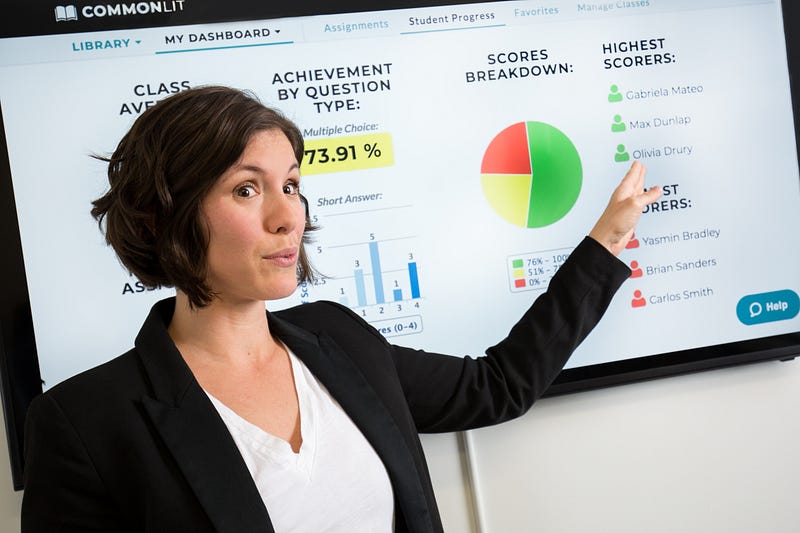Jayne VanNosdall is the Curriculum Supervisor of English (6–12) for Brick Township Public Schools in New Jersey. For this Q&A, Jayne spoke with CommonLit’s Director of School Partnerships, Rob Fleisher. Jayne explains how her team utilized CommonLit’s digital curriculum, formative data tracking, and interim assessments to drastically improve student performance.
Rob Fleisher, Director of School Partnerships for CommonLit: Your district has chosen to implement CommonLit’s full reading program — the free digital library, CommonLit Formative Insights and CommonLit Interims. Why did you choose to invest in these tools?
Jayne VanNosdall, Curriculum Supervisor of English (6–12) for Brick Township Public Schools, New Jersey: Our textbooks are dated and we’re not looking to make a new purchase in replacing them. In today’s education world, I don’t think that textbooks are the way to go. As a district, we’re looking to have multiple kinds of resources that are standards aligned. So, one of the reasons that we went with CommonLit is because it is standards-aligned. Before we started using CommonLit, I’m not really sure that there was any uniformity or consistency in teaching the standards. CommonLit gave us that uniformity and consistency for all teachers that were aligned to the test and aligned to the standards.
In 17–18, the year we began using CommonLit’s lessons in our weekly instructional practice and their interim assessments, our percent of students who were meeting or exceeding expectations in grade 9 soared to 22% over the state average in one school’s case.
Rob: How would you say CommonLit’s digital library is used as part of instruction?
Jayne: In grade levels, teachers seek out pieces on CommonLit that might be thematically linked to their unit or novel. After we do the CommonLit interim benchmark at the beginning of the semester, teachers can also look at the standards that are the weakest. They then go to CommonLit, search by standard, then choose a certain text that is going to support the standards that they know their students are weak in. We look at that data globally as a department but we also take time during our professional development days for each teacher to look at their own class’ data to see which standards have been most challenging for their students. Students in a class are often weak in a few particular standards and CommonLit makes it easy for teachers to choose a text and related activity that support that standard.
Rob: Can you explain why you chose to administer CommonLit’s Interim Assessments at different parts of the semester?
Jayne: Three years ago when we started using CommonLit, teachers used it as a supplemental resource. I encouraged teachers to try it out, and they identified it as a valid resource, but there was no uniformity or consistency across our high school classrooms.
In New Jersey, we have something called Student Growth Objectives (SGOs). SGOs are an opportunity for teachers to work with school and district administrators to create a long-term growth goal for their students. So, this meant that we needed a common way to assess our students’ performance from the beginning of the semester to the end of the semester.
A few years ago, we had a home-grown 25 question test. However, it was pretty much rote and it wasn’t assessing the standards. It was just assessing students’ memory. So, I made the decision to use CommonLit’s Interim Assessments to help us calculate the data for the SGOs, but also to track the students’ achievement on specific standards.

Rob: I know that your team had a large gain in student performance last school year. Can you talk a little bit about those gains?
Jayne: After examining longitudinal data in both 2016–2017 and 2017–2018 in grades 9 and 10, the growth on our ELA state assessment was impressive. The global gains presented here were calculated using both the Fall and Spring Administrations of the grades 9 and 10 ELA PARCC (New Jersey’s state exam) in 16–17 and again in 17–18; 17- 18 was the first year we used CommonLit with fidelity in grades 9 and 10. Here is what we found: In 16–17 we scored below the state average percentage of students meeting or exceeding expectations in grade 9 and 10. In 17–18, the year we began using CommonLit’s lessons in our weekly instructional practice and their interim assessments, our percent of students who were meeting or exceeding expectations in grade 9 soared to 22% over the state average in one school’s case. Similar results were seen in grade 10. Our students scored 19% over the state average on one administration, and 12% over the state average in a different administration of the assessment in the same year.
I attribute our gains to the quality practice and exposure our students had with the standards-based resources CommonLit has to offer. We also offered a lot of PD on standards-based instruction and adopted a new teacher evaluation model that also supported standards-driven planning and instruction. CommonLit provided an excellent platform for teachers to incorporate texts and related question that were aligned to the very standards we had determined our students were weak in. Teachers could determine which standards their students were weak in based on the state assessments, and then have students practice with that standard in CommonLit.

Rob: How did CommonLit help drive student growth? What were some of the changes you saw?
Jayne: Your testing platform is aligned beautifully to how our state’s PARCC platform looks. This gives our students the practice that they need taking assessments online.
CommonLit’s digital library also gives our students some of the constant practice that they need. I’ll also be the first to say that CommonLit is rigorous — it’s challenging — and that’s one of the biggest challenges that we were having as a district. As a district, we weren’t necessarily providing a challenge to the students, with regards to the type of texts or questions we were using. With all of CommonLit’s tools, we’re better able to prepare students for our state test.
Rob: Your team has used CommonLit’s Interim Assessments for the past 2 years. What can you share about those interims? How have they helped your team?
Jayne: The quality, the length, and the relatability of the reading passages are spot on. Students get tested a lot, so they naturally get a little frustrated when it’s time for another benchmark, but truth be told, they are working their hardest on it, and the passages that you present to them are relatable and the tasks are all standards- aligned. It’s always clear which standards are being addressed.
I should also mention that the tests aren’t too long. We have an 80-minute block, and for the most part, students are able to complete the assessment in that one instructional block.
It gives them quantifiable data starting with the first Interim Assessment at the beginning of the semester, weekly formative assessments throughout the semester, and then the end of semester test. So, for the first time, it is data that they can look at regularly.
Rob: Do your teachers see the CommonLit assessments as strong tests? Are they invested in the results?
Jayne: At first, I had some conversations with teachers on my team who were concerned with using CommonLit’s Interims Assessments for their SGOs because they felt like the assessments could be an unknown variable. But, I have had a few conversations with teachers who were shocked by how much better their students did at the end of the semester compared to how students did at the beginning of the semester. They were pleasantly surprised by the amount of growth that they saw students make.
Rob: How have you seen teachers change their habits since you began implementing CommonLit’s interim assessments? Do teachers think that teachers approach teaching in a new or different way because of them?
Jayne: I think it heightens their awareness of student achievement. It gives them quantifiable data starting with the first Interim Assessment at the beginning of the semester, weekly formative assessments throughout the semester, and then the end of semester test. So, for the first time, it is data that they can look at regularly.
It used to be that we’d get the PARCC results, we’d look at it once or twice per year, and that would be it. There wasn’t really any mechanism in place for looking at quantifiable data. I also think that by using CommonLit, there might be more awareness of the specific standards and what the questions look like for each standard. In the past, I’m not really sure if they understood how particular questions aligned to particular standards.

Rob: Your teachers use CommonLit’s digital library quite frequently. Have you had the chance to observe a teacher use CommonLit in a way that you thought was really effective or creative?
Jayne: What I also really like about CommonLit is how teachers can search for texts that align to the topics and themes in their units.
For example, one of our new teachers was teaching a novel unit on Of Mice and Men. To introduce the book, she found three articles on CommonLit that helped provide background knowledge. So, she divided the class into groups for a jigsaw activity, had students do a close read of the text that they were assigned. I thought that was a really creative way to infuse CommonLit into daily instruction.
Rob: What has it been like to work with members of CommonLit’s team?
It has been delightful! I can’t even. I woke up this morning thinking, ‘Oh, I get to have this nice conversation with Rob.’ It’s been delightful — your positivity, your can-do attitude. And my teachers say the same thing. They know that if they email you they are going to get a really quick and helpful response. It has been a really professional and pleasant experience.
Next Steps
Click here to learn more about CommonLit’s District Solutions. To connect directly with me or another member of our School Partnerships Team, send an email to Partnerships@CommonLit.org to schedule a call.


